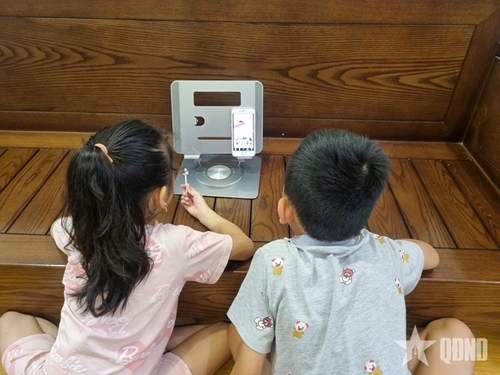Children are naturally curious and eager to explore new things. The development of science and technology, including AI, has brought many opportunities for children to learn and play. However, they are also among the most vulnerable groups. AI has the ability to create contents at an astonishing speed and with a high degree of realism, making it difficult for viewers to distinguish between real and fake. With just a few simple keywords and a popular AI tool, anyone can generate images or videos to their liking. Alarmingly, such contents do not always produce positive effects, quite the opposite, in many cases.
    |
 |
|
Parents should accompany and guide their children in using AI properly, and closely monitor the contents their children access through AI platforms. |
Frequent exposure to harmful content not only frightens children, but can also seriously affect their personality development, behavior, and cognitive abilities. Many young children tend to imitate behaviors like hitting, kicking, or using inappropriate language.
According to Le Thi Hong Nhung from Nong Trang ward, Phu Tho province, she discovered that her son was watching an animated video that seemed harmless at first, but it contained violent images and behaviors. What is worrying is that the video was tagged with popular cartoon characters to attract children and generate revenue through a video-sharing platform. Upon further investigation, she learned that the video was AI-generated and had been recommended by YouTube app.
Many other parents have also expressed confusion and concern over the rapid development of AI technology and the associated risks for their children. They hope for more concrete tools and guidelines to help protect their children in the digital space.
Cybersecurity expert Ngo Minh Hieu (also known as Hieu PC) stated that the ability of AI to generate harmful content poses a significant challenge as we are dealing with technology that can learn and adapt. Traditional tools for detecting harmful content are often ineffective against AI. We should use AI itself to detect and block harmful content created by other AI systems, while enhancing investment in the research and development of advanced technologies to accurately identify deepfake contents.
According to lawyer Tran Hong Tinh, Director of Duc Tri An Law Firm, from a legal perspective, the dissemination of harmful content targeting children can be handled under the provisions of the Law on Children, the Cybersecurity Law, the Penal Code, and other relevant regulations on child protection. However, when it comes to AI-generated content, identifying the violator, whether it is the creator, distributor, or hosting platform, is extremely complex. In the long term, Vietnam should promptly enact a law on artificial intelligence or amend existing laws to include specific provisions on digital content and AI. We need new legal regulations to define the responsibilities of AI developers and content-sharing platforms. In addition, automated content moderation tools must be introduced, especially for content targeting children.
As AI is developing faster than the legal framework, the role of families and schools becomes critically important. The family is the first and most essential "barrier" to protect children. Parents cannot rely entirely on control applications or schools, as harmful content generated by AI is becoming increasingly sophisticated and capable of bypassing technical filters. Parents should regularly check browsing history and screen time, install content control software such as Google Family Link or YouTube Kids, and guide their children on how to distinguish between reliable and harmful content, among others.
Translated by Quynh Oanh